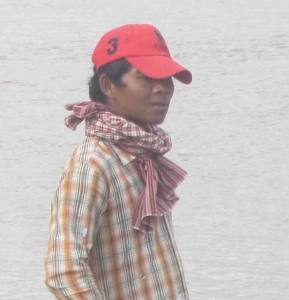As a young child I remember seeing footage on the television of scenes such as this coming from Cambodia.

My enduring memories include a guy called Pol Pot, said by Mum to be “a very bad man”, and soldiers in black pyjamas with a checked scarfe. With the exception of the occasional elderly person, the population have generally rejected black for bright, floral pyjamas, worn to my amusement at all times of day or night and in all public places, from shopping at the market to working on a construction site.
The checked scarfe, known as a “krama”, remains an abiding item of Cambodian attire. Often the only thing men appear to have on, it has a wide and surprising variety of uses. The many Khmer people I have asked all admit owning and using a krama. Sold for between $1 (local marketplaces) and $5 (tourist hotspots), I too now own and use kramas, mostly as a bandana against the dust and sun when I’m out cycling.
Traditionally a gingham pattern of red (most commonly as you can see by my photographs) or blue, kramas are made in “silk villages” using cotton or silk. A “silk village” seems to be any village where the dirt floor area under someone’s traditional elevated wooden home contains a foot-pedalled loom used to weave krama. There are many “silk villages” dotted throughout Cambodia where you can visit to observe this traditional weaving.

It’s probably impossible to provide an exhaustive list of the uses of a krama because I doubt I’ve seen or imagined them all. But I do see them everyday and it is astounding just how many practical functions one smallish strip of material has.
Perhaps most commonly, men wear them as a skirt in the hot and steamy climate. They also come in handy when bathing in public, as most people do, in either the river or from the large pottery rainwater tanks most villagers have in their open yards. You can wash without getting naked. They are also used as a towel by most people.

Perhaps the next most common use of a Krama is as a sunhat of sorts, either on it’s own or in combination with a hat.


When you don’t need full sun protection but you want your krama nearby, they tie nicely around your scalp like a turban. This can also help as a way of stabilising the trays of produce people carry on their heads.
Women tend to wear them in a looser style unless using it to anchor a tray of produce.
They make great slings and carry-bags.
They can be slung between structures including the handlebars of bicycles, as a makeshift hammock for babies and small children. I’m yet to capture a pic of this. And they’re also used as decoration, which I suspect is in order to have it on you for when you happen to need it next.
There are apparently regional varieties to krama, which I am yet to work out. They were described by a Chinese visitor to Angkor Wat in the 13th century, indicating their historical significance.
Next to wearing your bright floral pyjamas in broad daylight, the krama must be one of present day Cambodia’s most symbolic cultural statements.















My favourite is turban style – very chic! But men wearing them as a longer length skirt look good as well. What a useful item!
LikeLike
Kroma: Krama has been a symbol of Cambodian scarf is known after the dated from the Angkor period. Krama became fashionable in everywhere in Cambodia.
Krama is considered perfectly acceptable outerwear in Cambodia, especially for Khmer men wear it during the day and night. The flannel is considered just too hot in Cambodian climate. I wear Kroma daily after work and in bed as well.
LikeLike